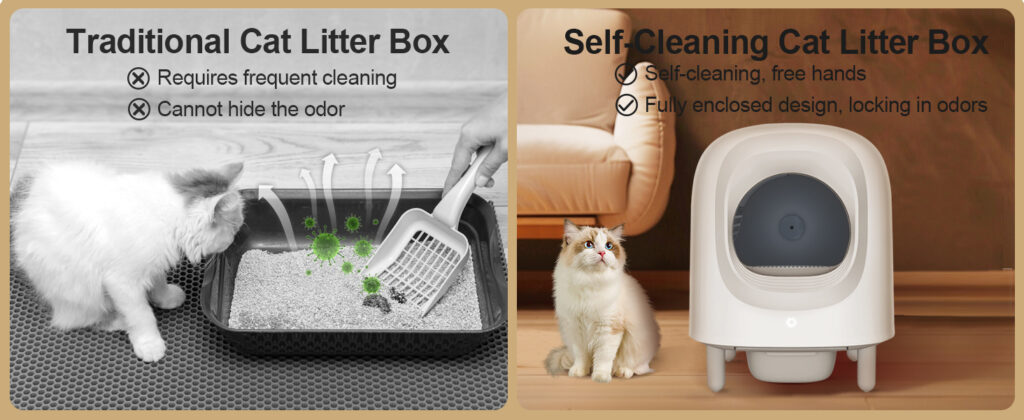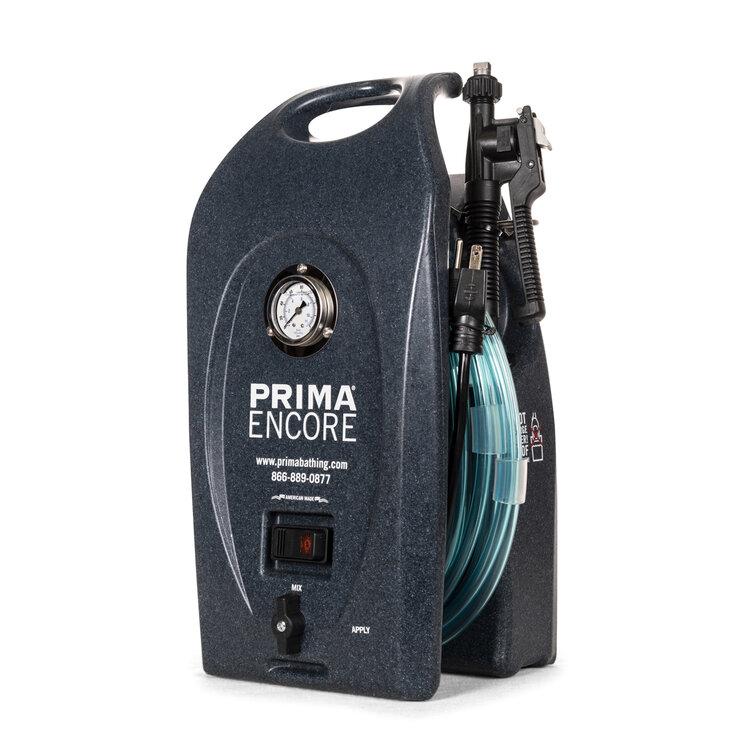How does a self-cleaning cat litter box work?| Best self-cleaning cat litter box
Are self-cleaning litter boxes worth the investment?
What are the benefits of a self-cleaning litter box for multiple cats?
How Does a Self-Cleaning Cat Litter Box Work?
Owning a cat is a joy, but let’s be honest: cleaning the litter box is not anyone’s favorite task. That’s where self-cleaning cat litter boxes come in—a high-tech solution to this everyday chore.

But how do they work? we’ll break down the inner workings of these nifty devices, explore their advantages and challenges, and help you decide if they’re right for you and your feline friend.
What is a Self-Cleaning Cat Litter Box?
A self-cleaning cat litter box is designed to automate the process of cleaning up after your cat. Instead of you manually scooping out the waste, the litter box does the job for you.
It’s equipped with a mechanism that separates the solid waste from the clean litter and deposits it into a sealed container or bin. This helps keep the litter box clean and minimizes the smell, which is one of the main reasons cat owners switch to these devices.
How Traditional Litter Boxes Work
Let’s start by comparing the self-cleaning model with a traditional litter box. In a regular box, you have to manually scoop out your cat’s waste at least once a day, which can be time-consuming and, let’s face it, not the most pleasant task.
Odor can become a problem quickly if the litter isn’t cleaned frequently enough. Plus, some cats might even refuse to use a dirty litter box, which only adds to the urgency of keeping it spotless.
The Basic Working Mechanism of Self-Cleaning Litter Boxes
The self-cleaning box automates this process. Here’s a simplified breakdown of how it works:
- Waste Detection: Sensors detect when your cat has used the litter box.
- Cleaning Cycle: After a set period of time, the litter box initiates a cleaning cycle.
- Waste Separation: The box typically has a raking system or rotating mechanism that sifts through the litter, collecting waste.
- Waste Disposal: The waste is deposited into a compartment, which can be emptied periodically.
The Role of Sensors in Self-Cleaning Litter Boxes
One of the key features of a self-cleaning litter box is its ability to detect when your cat has used the litter. Most models use motion or weight sensors to track when the cat enters and exits the box.
Once the sensors register that the cat has left, the box waits for a set amount of time (usually 5-20 minutes) before initiating a cleaning cycle. This delay allows the litter to clump, making the waste easier to scoop.
Sensors are also a crucial safety feature. They ensure that the cleaning mechanism doesn’t activate while your cat is still inside, preventing accidents.
Raking and Scooping Mechanisms
Depending on the model, the cleaning mechanism may vary. Some litter boxes use a raking system that sifts through the litter and moves the waste into a storage compartment.
Others use rotating drums or conveyor belts to separate the waste from the clean litter. These systems are designed to reduce the amount of litter used and ensure that the box remains clean and odor-free.
The frequency of the cleaning cycle can often be adjusted, allowing you to set the machine to clean after every use or at certain intervals.
Waste Disposal System
After the litter is cleaned, the solid waste is moved to a sealed bin or disposable bag. This compartment helps to control odors and is typically designed to be easy to remove and replace. Most bins need to be emptied every few days to a week, depending on how many cats you have and how often the litter box is used.
Types of Self-Cleaning Cat Litter Boxes
There are several different types of self-cleaning litter boxes:
- Fully Automatic Models: These are the most high-tech, taking care of everything from waste removal to odor control.
- Semi-Automatic Models: These require a little more manual involvement, but still offer significant help with cleaning.
- Open vs Enclosed Designs: Enclosed models offer better odor control, while open designs give your cat more room and visibility.
Common Features of Self-Cleaning Litter Boxes
Most self-cleaning litter boxes come with features like:
- Adjustable timers to control the delay before the cleaning cycle starts.
- Odor control systems, such as carbon filters or automatic sprays.
- Easy maintenance designs that allow for quick emptying of the waste compartment and refilling of litter.
What Kind of Litter Do Self-Cleaning Litter Boxes Use?
Most self-cleaning litter boxes work best with clumping litter. This is because the mechanisms rely on clumps of solid waste being easy to separate from the clean litter. Using non-clumping or very fine litter can cause jams and malfunction.
Always check the manufacturer’s recommendations to avoid using incompatible litter that could affect the machine’s performance.
Energy and Power Requirements
Self-cleaning litter boxes either run on batteries or need to be plugged into a power outlet. Plug-in models are generally more powerful and reliable, but battery-operated versions offer flexibility in placement around the home. Power consumption is relatively low, and some models even feature eco-friendly modes to reduce energy usage.
What are the benefits of a self-cleaning litter box for multiple cats?
Owning multiple cats means double—or sometimes triple—the love, but it also means double the work when it comes to cleaning the litter box. Managing waste for more than one cat can quickly become overwhelming with a traditional litter box.
This is where a self-cleaning litter box can be a game-changer. These devices offer several benefits for multi-cat households, helping to make pet care easier and more efficient. we’ll explore the key benefits of a self-cleaning litter box for homes with multiple cats. Read more
APP Control & Health Monitoring
Control your self-cleaning litter box remotely with the APP at any time and from any location, while also continuously monitoring your cat’s health and activity.
The App allows you to manage the cat litter box, enabling one-touch cleaning and real-time tracking of weight, frequency of toilet use, and more. Anomalies in data can assist in the early detection of potential health issues in cats, potentially reducing treatment expenses.
Potential Drawbacks and Challenges
Of course, there are some downsides:
- Cost: Self-cleaning litter boxes can be expensive, especially high-end models.
- Noise: Some users report that the cleaning mechanisms can be loud, which might disturb your cat.
- Maintenance: While these boxes reduce manual cleaning, they still require occasional upkeep, like emptying the waste bin and refilling the litter.
Tips for Transitioning Your Cat to a Self-Cleaning Litter Box
Some cats may be wary of a new litter box, especially one that moves and makes noise. To make the transition easier:
- Introduce Gradually: Place the self-cleaning box next to the old one and allow your cat to get used to it.
- Manual Mode First: Some models allow you to run the cleaning cycle manually, so your cat isn’t startled by unexpected movement.
- Familiar Litter: Use the same litter your cat is already accustomed to, at least in the beginning.
FAQs
- How often do I need to empty the waste compartment?
- Most boxes need to be emptied every few days to a week, depending on usage.
- Can multiple cats use the same self-cleaning litter box?
- Yes, many models are designed to accommodate multiple cats, but you may need to empty the waste compartment more often.
- Is there a learning curve for cats using self-cleaning litter boxes?
- Some cats may need time to adjust, but most adapt within a few days with gradual introduction.
- What happens if the sensors fail?
- Most boxes have safety features, but if sensors fail, you might need to troubleshoot or manually clean the box.
- How long do self-cleaning litter boxes typically last?
- With proper maintenance, they can last several years, though warranties typically cover 1-2 years of use.
Conclusion
Self-cleaning cat litter boxes can be a game-changer for pet owners who want to save time and reduce the hassle of cleaning up after their cats. While they come with an upfront cost and require some maintenance, the convenience and odor control they offer can make them well worth the investment.
If you’re tired of daily scooping and are ready for a tech-savvy upgrade, a self-cleaning litter box might just be the perfect solution for you and your cat.




